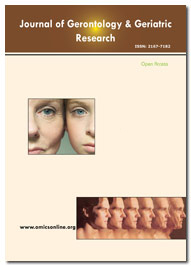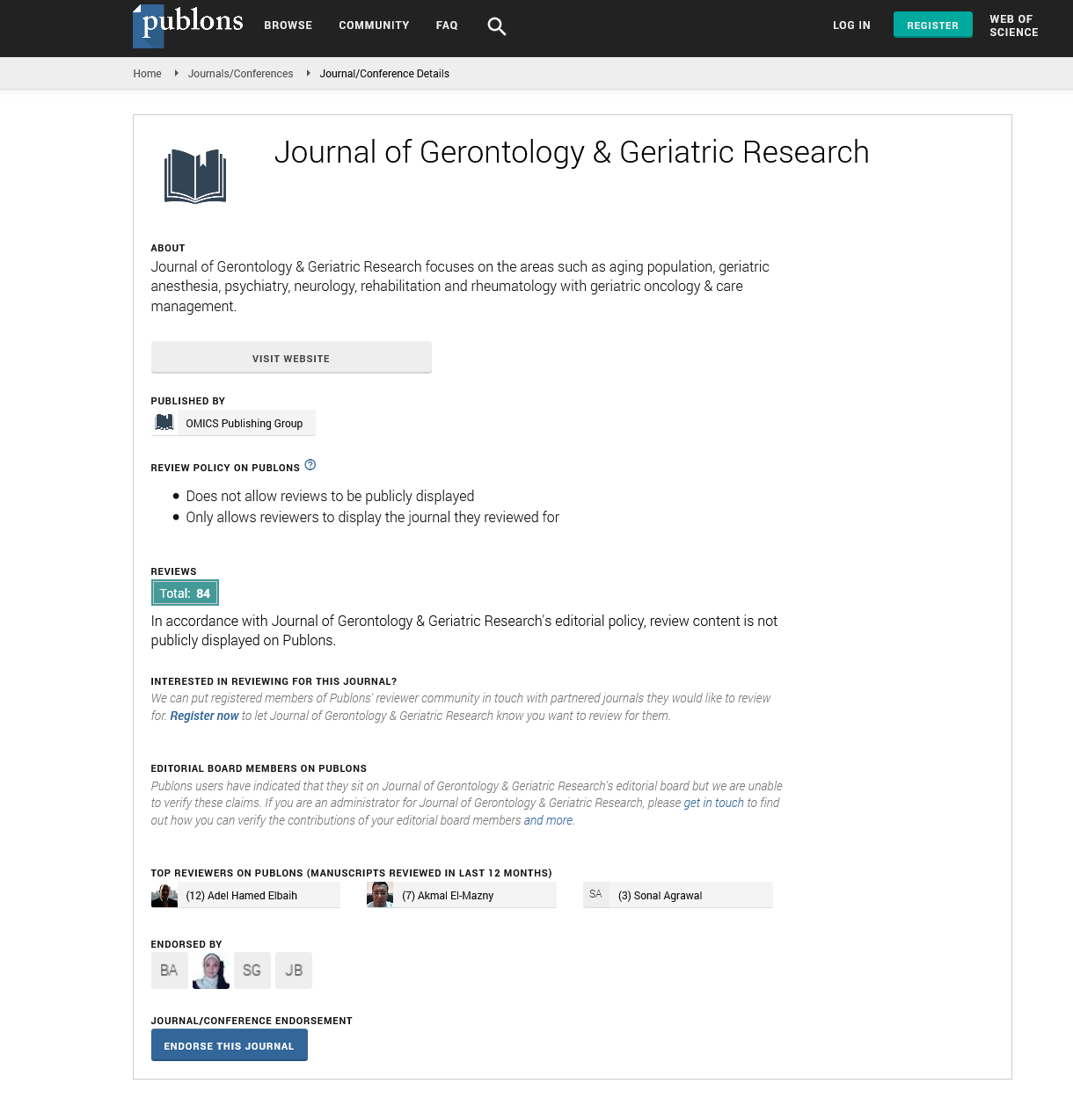Indexed In
- Open J Gate
- Genamics JournalSeek
- SafetyLit
- RefSeek
- Hamdard University
- EBSCO A-Z
- OCLC- WorldCat
- Publons
- Geneva Foundation for Medical Education and Research
- Euro Pub
- Google Scholar
Useful Links
Share This Page
Journal Flyer

Open Access Journals
- Agri and Aquaculture
- Biochemistry
- Bioinformatics & Systems Biology
- Business & Management
- Chemistry
- Clinical Sciences
- Engineering
- Food & Nutrition
- General Science
- Genetics & Molecular Biology
- Immunology & Microbiology
- Medical Sciences
- Neuroscience & Psychology
- Nursing & Health Care
- Pharmaceutical Sciences
Perspective - (2022) Volume 11, Issue 6
Brief note on Geriatric Intervention
William Garbrah*Received: 02-Jun-2022, Manuscript No. JGGR-22-18140; Editor assigned: 04-Jun-2022, Pre QC No. P-18140; Reviewed: 14-Jun-2022, QC No. Q-18140; Revised: 20-Jun-2022, Manuscript No. R-18140; Published: 25-Jun-2022, DOI: 10.35248/2167-7182.2022.11.616
Introduction
Poor surgical outcomes, such as prolonged postoperative length of stay (LOS), intensive care unit (ICU) utilisation, and readmissions, are frequent in older patients with gastrointestinal (GI) malignancies. Geriatricians' involvement in the treatment of older cancer patients can lead to better results. A perioperative geriatric intervention was tested in a randomised study on older patients with GI malignancies who were undergoing surgery. Methods: Patients with GI malignancies under 65 years old who were scheduled for surgical resection were randomly randomised to receive either the standard of care or a perioperative geriatric intervention. Preoperatively and postoperatively, intervention patients saw a geriatrician as an inpatient consultant. The surgical and oncology teams received advice from the geriatrician once the geriatric exam was completed. The post-op LOS was the main end point. Secondary end points included. Health issues are a result of the rising proportion of older people in nations whose life expectancy is high, like Japan. Frailty, which is defined by a decline in physiological reserve and resistance to stresses as well as an increase in vulnerability to unfavourable events, is one of the most important socioeconomic challenges in these nations. 1 One of the biggest challenges to public health in the twenty-first century is fragility. Frailty has recently come to be understood as a complex phenotype that encompasses sociological, psychological, and physical decline. 2, 3 Sarcopenia may also be the primary or one of the major causes of frailty, particularly physical frailty, according to certain theories. Sarcopenia is linked to poor health outcomes like functional decline and mortality, according to recent meta-analyses [1].
Description
The most effective intervention for boosting muscular mass and strength in elderly persons has been thought to be resistance exercise. 6-8 Sarcopenia is particularly well documented to be prevented by resistance training with a high load (80% onerepetition maximum (1RM)). 9, 10 However, high-load resistance training typically necessitates the use of exercise equipment (such as machines) and trained instructors. As a result, many older persons who live in the community could find it challenging to engage in high-load resistance exercise because they lack access to resources or training. Low-load exercise, on the other hand, needs very little gear and doesn't need specialised space. While this is going on, numerous studies have discovered that low-load resistance exercise has hypertrophic effects on older persons [2].
In order to lower the number of elderly people who are certified for long-term care and the accompanying expenditures, the Ministry of Health, Labour, and Welfare of Japan underlined the significance of comprehensive community-based initiatives. 25 Our study team created a complete geriatric intervention programme (CGIP) with resistance exercise, physical activity increments, dental functional care, and a dietary guidance in compliance with the Ministry of Health, Labour, and Welfare report. We carried out a clusterrandomized controlled trial (RCT) with this CGIP in Kameoka City, Kyoto Prefecture, Japan. The purpose of this study was to assess how a 12-week CGIP affected community-dwelling older adults' daily physical activity, bodily processes, and skeletal muscle size. Additionally, we contrasted the outcomes of supervised and unsupervised self-monitoring [3-5].
Conclusion
The CS group was required to participate in weekly 90-minute supervised exercise sessions after the third week of the intervention period and was given instructions to complete the programme on their own the remaining days. The HB group received programme instructions but not programme monitoring. The HB group was given the option of attending a lecture between the fifth and sixth weeks of the intervention period. The HB group participants completed the training on their own time at home. The weekly supervised sessions that the CS group began receiving after the third week were the sole variation between the two types of intervention. All lectures and sessions were held in Kameoka City's community centres, one for each region. Six individuals from our lab, including a health and fitness programmer, Randomized controlled trials (RCTs) have demonstrated that geriatric intervention increases overall survival (OS) in the general aged population. However, only a small number of RCTs-with mixed results-have particularly looked into the influence on aged cancer patients. In a sub-analysis of a larger trial, reported no difference in 1-year survival following geriatric case-management for older cancer patients, and found no influence on 1-year mortality after a dietary intervention. An RCT with case-management in the form of a one-month nurse intervention for post-surgical elderly cancer patients, including 375 patients older than 60 years, found an improvement in survival; however, this advantage was only shown in the sub-population of patients with advanced disease.
REFERENCES
- Altfeld SJ. "Effects of an enhanced discharge planning intervention for hospitalized older adults: a randomized trial." The Gerontologist. 2013; 53:430-440.
- Arendts G. “A randomized-controlled trial of a patient-centred intervention in high-risk discharged older patients.” Euro J Emerg Med. 2018;25:237-241.
- Clegg A. “Frailty in elderly people.” The lancet. 2013;381:752-762.
- Conroy T. “In-hospital interventions for reducing readmissions to acute care for adults aged 65 and over: An umbrella review.” Inter J Quality Health Care. 2020;32:414-430.
- Deniger, A. “Geriatric transitional care and readmissions review.” J Nurse Practit. 2015;11:248-252.
Google Scholar, Crossref, Indexed at
Google Scholar, Crossref, Indexed at
Google Scholar, Crossref, Indexed at
Google Scholar, Crossref, Indexed at
Citation: Garbrah W (2022) Brief note on Geriatric Intervention. J Gerontol Geriatr Res. 11: 616.
Copyright: © 2022 Garbrah W. This is an open-access article distributed under the terms of the Creative Commons Attribution License, which permits unrestricted use, distribution, and reproduction in any medium, provided the original author and source are credited.

